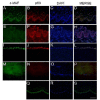C-MAF Expression in Adult Human Ocular Surface and its Implication in Pterygium Pathogenesis
- PMID: 32582801
- PMCID: PMC7275840
C-MAF Expression in Adult Human Ocular Surface and its Implication in Pterygium Pathogenesis
Abstract
Background: c-MAF, a transcription factor that belongs to the b-Zip Maf transcription factor family, was found to be critical for lens development in vertebrates. It is a well-known fact that the adult human ocular surface expresses c-MAF, however, its role in the limbus, cornea and conjunctiva remains unknown. Thus, the present study aimed to investigate c-MAF expression within the human ocular surface, and its potential role in pterygium pathogenesis.
Methods: We performed immunohistochemical staining to detect c-MAF expression in frozen adult human tissue sections, including the limbus, cornea and conjunctiva, and cultured cells from eye cadavers. We then compared c-MAF expression to the expression of a known protein, P63. Lastly, we performed RT-PCR, and immunohistochemistry for c-MAF expression in healthy adult human conjunctiva and pterygium.
Results: We found differential c-MAF expression between adult human limbus, cornea and conjunctiva tissues. Further, we observed that c-MAF is downregulated in the pterygium compared to healthy conjunctiva.
Conclusion: Overall, our results suggest that c-MAF may play a context-specific role in maintaining limbal, corneal and conjunctival homeostasis, and may be critical for preventing pterygium development in humans.
Keywords: C-MAF Expression; Conjunctiva; Human Ocular Surface; Pterygium.
Figures





Similar articles
-
Limbal stem cell transplantation: an evidence-based analysis.Ont Health Technol Assess Ser. 2008;8(7):1-58. Epub 2008 Oct 1. Ont Health Technol Assess Ser. 2008. PMID: 23074512 Free PMC article.
-
Expression analysis of human pterygium shows a predominance of conjunctival and limbal markers and genes associated with cell migration.Mol Vis. 2009 Nov 20;15:2421-34. Mol Vis. 2009. PMID: 19956562 Free PMC article.
-
Localization of the low-affinity nerve growth factor receptor p75 in human limbal epithelial cells.J Cell Mol Med. 2008 Dec;12(6B):2799-811. doi: 10.1111/j.1582-4934.2008.00290.x. J Cell Mol Med. 2008. PMID: 19210757 Free PMC article.
-
Conjunctival grafting for ocular surface disease.Curr Opin Ophthalmol. 1999 Aug;10(4):277-81. doi: 10.1097/00055735-199908000-00010. Curr Opin Ophthalmol. 1999. PMID: 10621536 Review.
-
Immunohistochemical profile of VEGF, TGF-β and PGE₂ in human pterygium and normal conjunctiva: experimental study and review of the literature.Int J Immunopathol Pharmacol. 2012 Jul-Sep;25(3):607-15. doi: 10.1177/039463201202500307. Int J Immunopathol Pharmacol. 2012. PMID: 23058011 Review.
Cited by
-
Calcitonin Gene-Related Peptide Regulates Specific Interferon-Stimulating Genes to Inhibit Apoptosis of Corneal Epithelial Cells in Dry Eye Disease.Invest Ophthalmol Vis Sci. 2025 Jul 1;66(9):65. doi: 10.1167/iovs.66.9.65. Invest Ophthalmol Vis Sci. 2025. PMID: 40728362 Free PMC article.
References
-
- Kienast J, Berdel WE. c-MAF in multiple myeloma: an oncogene enhancing tumor-stroma interactions. Cancer cell . 2004;5(2):109–110. - PubMed
LinkOut - more resources
Full Text Sources
